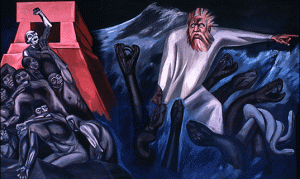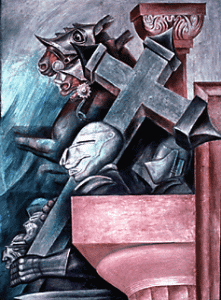Reading Response #1: The Orozco Murals at Dartmouth College
Orozco’s mural of The Epic of American Civilization in Baker Library at Dartmouth College is a brilliant visual representation of the dichotomy between the ancient and modern world. In the mural, Orozco dedicates the west wing of the room to pre-Columbian images and the east wing to images of post-Cortez America. The panel “Departure of Quetzalcoatl” along with “The Prophecy” are especially important since they act as the transition between the two seemingly dissimilar ancient and modern worlds.
Comprehensive understanding of Orozco’s intention for this panel depends on prior knowledge of the Mesoamerican myth of Quetzalcoatl. Quetzalcoatl was one of the main gods of pre-Hispanic civilizations and his name roughly translates to mean “the plumed serpent”. He was believed to be both a human and a god, a deity who took on human form to impart godly knowledge to man[1]. He is said to have departed from this world by sailing off on a raft of serpents, driven out by evil spirts and a nation that had “rejected his teachings”[2]. He is depicted throughout history as a tall and bearded white male. His European resemblance led the Indians to mistake Cortez for him upon the conquistador’s arrival in the New World, unfortunately inspiring Indian generosity and friendliness towards the Spaniards that would ultimately lead to their demise.
There are many aspects of this panel that lead the viewer to believe Orozco is in fact referencing this specific myth. The viewer’s eyes are immediately drawn to the white, bearded man dominating the frame. His distinct European features strongly contrast the Indian figures previously depicted in the mural. This contrast leads us to infer his identity as Quetzalcoatl as well as highlights his distinction from the indigenous people, a distinction that represents his godly identity. His godly identity is further solidified by the earlier panel “Coming of Quetzalcoatl” where an identical figure is depicted among other gods of the ancient world. The figure is also notably larger than the Indians on the left side of the panel. I find it interesting that the major god of Mesoamerican has European features, and I contemplate its place in a mural that displays an overall pessimism towards the Spanish colonialism. Historians speculate that the god’s European features might result from the myth of Quetzalcoatl being based on reality, speculating that a Viking could have possibly made its ways to Mexico earlier in the century and been considered a god for his knowledge and bizarre complexion[3]. Quetzalcoatl’s European features therefore are more likely a result of Orozco trying to comply with the myth rather than him commenting on the relationship between Europeans and Indigenous people. In addition to his physical features, the figure is also surrounded by snakes and waves, images that are in accordance with the myth regarding Quetzalcoatl’s departure from this world on a raft of snakes.
The viewer cannot fully experience the previously discussed panel the “Departure of Quetzalcoatl” without contemplating the adjacent panel “The Prophecy”. Quetzalcoatl’s dramatic hand slices across the panel and the viewer is naturally inclined to look where he is pointing. Through careful analysis, it is obvious that the scene the god is pointing to conveys the coming of the Spaniards. Even without larger context of the overall theme of the mural, there are many elements of this panel that lead the viewer to infer that the relatively nondescript masked knights are indeed Spaniards. First off, historically the Spaniards are responsible for bringing Christianity to the new world. The knight in the forefront is carrying a cross, representing the Spaniards’ role as not only conquistadors but as missionaries. The alarming sharp points at the ends of the cross are striking, and allude to the brutal and total domination the Spaniards used to force indigenous people to abandon their long held beliefs and adopt Christianity. The horses in the background also help the viewer identify the knights as Spaniards since Cortez and his men are credited for bringing the first horses to Mexico. Lastly, the Doric and Corinthian style columns present in the forefront and background of the panel are of obvious European origin. This style of architecture especially contrasts the indigenous style of architecture depicted in the ancient temples in the previous panels.
The beauty of these panels, as well as the mural as a whole, is that they parallel other panels in the room, leading the viewer to make nuanced connections. For example, I think that “Departure of Quetzalcoatl” and “The Modern Migration of the Spirit” strongly parallel each other. For one, the story of Quetzalcoatl and Jesus are strikingly similar. Both are gods that take on human form, both come to teach the humans something, and both leave and are thought to one day return. Quetzalcoatl appears to be the Jesus of the ancient world. This connection is solidified when comparing the two panels. The Quetzalcoatl panel is dominated by dark grays and blues whereas the Jesus panel has bright reds and yellows. I believe Orozco intentional uses opposite color schemes to demonstrate the contrast between the ancient and modern world and their two gods. As exemplified by these two panels, Orozco’s use of parallelism is ultimately what makes this mural such an iconic piece of art.
[1] “Myths Encyclopedia.” Quetzalcoatl. N.p., n.d. Web. 12 Jan. 2017.
[2] Rochfort, Desmond. Mexican Muralists: Orozco, Rivera, Siqueiros. San Francisco: Chronicle , 1998. Print.
[3] “Myths Encyclopedia.” Quetzalcoatl. N.p., n.d. Web. 12 Jan. 2017.


